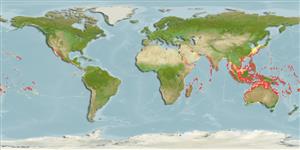Common names from other countries
Environment: milieu / climate zone / depth range / distribution range
экология
; пределы глубины 0 - 100 m (Ref. 348), usually 0 - 5 m (Ref. 348). Tropical
Indo-Pacific: from East Africa, to eastern Polynesia; north to Japan and south to Queensland and New Caledonia.
Length at first maturity / Size / Вес / Возраст
Maturity: Lm ? range ? - ? cm Max length : 11.0 cm SHL самец/пол неопределен; (Ref. 348); common length : 8.5 cm самец/пол неопределен; (Ref. 348)
Maximum depth from Ref. 101147. Attached by its byssus to coral slabs, rubble under the slab (Ref. 101147), under coral heads and rocks (Ref. 348). Frequently encrusted by sponges, bryozoans, algae, and other marine growths. Able to swim actively for some distance when detached. Common in the intertidal and shallow subtidal zones (Ref. 348). Also occurs on rubble, soft sediments, and scattered reefs (Ref. 87907). At night, adults seem to move to open water to feed and return to rubble pile in the day (Ref. 101147).
Life cycle and mating behavior
половая зрелость | размножение | нерест | икра | Fecundity | личинки
Members of the class Bivalvia are mostly gonochoric, some are protandric hermaphrodites. Life cycle: Embryos develop into free-swimming trocophore larvae, succeeded by the bivalve veliger, resembling a miniature clam.
Основная ссылка
ссылки | координатор | соавторы
Poutiers, J.M. 1998. (Ref. 348)
Статус Красного Списка МСОП (Ref. 130435)
Статус СИТЕС (Ref. 108899)
Not Evaluated
Not Evaluated
Угроза для людей
Harmless
Использование человеком
| FishSource |
инструменты
дополнительная информация
Возраст/Размеры
рост
Зависимость между длиной и массой тела
Зависимость между длинами
морфология
личинки
численность
ресурсы в Интернет
Estimates based on models
Preferred temperature
(Ref.
115969): 24.6 - 29.2, mean 28.3 (based on 3624 cells).
Уязвимость
Low vulnerability (10 of 100).
